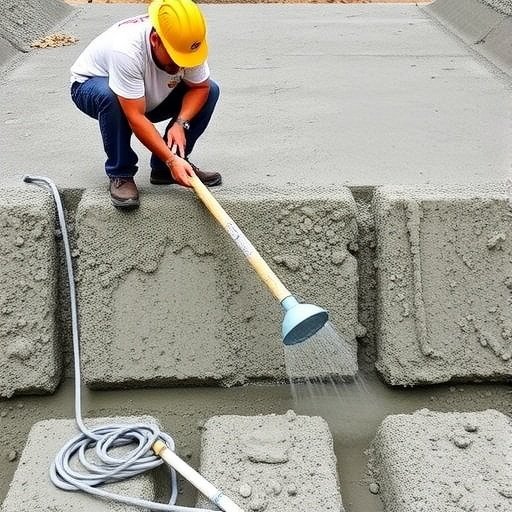Recent advancements in material science have taken a significant leap forward with the innovative work presented by Zhao et al. in their groundbreaking study published in Scientific Reports. This research explores the intriguing interaction between cement mortar and magnetized water that has been treated using a novel approach involving composite time-varying electromagnetic fields. This exploration holds promise for not only improving construction materials but also enhancing their properties in a way that could revolutionize the industry.
Cement mortar, a staple in the construction sector, typically relies solely on traditional methods of preparation and treatment. However, the novel concept of magnetizing water introduces a unique variable that researchers believe could alter the molecular structure of water. This change suggests the potential to enhance the bonding properties of cement, ultimately leading to superior strength, flexibility, and durability of the mortar.
In their experiment, Zhao and colleagues meticulously detailed the process of creating magnetized water. The researchers utilized specially designed apparatus capable of generating varying electromagnetic fields, which exposed water to a dynamic magnetic flux. This procedure not only magnetized the water but also instigated a series of molecular changes. Such changes are hypothesized to promote a more favorable interaction between the water molecules and the cement components during mixing and curing.
Through systematic experimentation, Zhao et al. determined that the incorporation of magnetized water significantly improved the mechanical properties of the cement mortar. Tests revealed that the compressive strength, tensile strength, and workability of the mortar improved substantially when magnetized water was utilized in the mixing process. These findings suggest that using magnetized water may lead to a more efficient cementitious composite, potentially resulting in reduced material costs and energy consumption in construction processes.
The implications of these findings extend beyond mere enhancements to mortar properties. The environmental considerations associated with reducing the quantity of cement needed in construction by leveraging the benefits of magnetized water could have significant ramifications for the industry’s carbon footprint. Cement production is notorious for its substantial greenhouse gas emissions, and utilizing advances like these could pave the way for a more sustainable future in construction practices.
Additional experiments conducted by the researchers employed a variety of electromagnetic field configurations to ascertain the optimal conditions for magnetizing water. It was discovered that specific combinations of frequencies and amplitudes resulted in the most significant enhancements to the physical properties of cement mortar. As a result, this opens up new avenues for tailored applications of composite electromagnetic fields in various construction materials.
Moreover, the research highlights the potential for these findings to drive further scientific inquiry into the effects of electromagnetic fields on other construction materials. The advancements made in this study serve as a foundation for exploring how other elements, such as additives and supplementary cementitious materials, could be impacted by the inclusion of magnetized water and electromagnetic treatment. This links well into ongoing research that seeks to enhance the performance and sustainability of building materials in innovative ways.
Zhao et al.’s findings not only introduce a revolutionary technique for cement mortar enhancement but also initiate a dialogue within the scientific community regarding the future of construction materials. The results have captured the attention of researchers looking to explore how the principles behind this study can be applied to a broader array of materials, thereby providing incentives for further exploration into the capabilities of magnetized water in other domains.
Furthermore, the experimental designs and methodologies employed in this research underscore the importance of interdisciplinary approaches in material science. The successful integration of physics, chemistry, and engineering concepts in this study provides a framework for future projects. This collaborative spirit is crucial as the construction industry faces challenges associated with climate change and global urbanization.
In conclusion, the implications of Zhao et al.’s research run deep, potentially transforming traditional construction practices. As the sector grapples with increasing demands for sustainability and improved performance, innovative methodologies such as those outlined in this study will undoubtedly play a critical role. By harnessing the unique properties of magnetized water, researchers may have unlocked a pathway to more efficient, durable, and environmentally friendly construction materials. The future of cement technology is on the precipice of exceptional advancements thanks to this cutting-edge research.
In summary, the experimental approach to cement mortar utilizing magnetized water treated by composite time-varying electromagnetic fields represents a noteworthy evolution in the field of materials science. The profound implications for both construction efficiency and environmental sustainability position this study as a pivotal moment in a continually evolving domain.
By continuing to explore innovative applications of advanced electromagnetic fields on construction materials, researchers can not only reshape the future of material science but contribute positively to a more sustainable built environment. As we anticipate the outcomes of this study’s ongoing influence, we can envision a future where the materials that shape our world are not only more effective but also inherently more responsible in their ecological footprint.
Subject of Research: The effects of magnetized water treated by composite time-varying electromagnetic fields on cement mortar properties.
Article Title: Experimental study on cement mortar with magnetized water treated by composite time-varying electromagnetic fields.
Article References:
Zhao, W., Wang, J., Li, T. et al. Experimental study on cement mortar with magnetized water treated by composite time-varying electromagnetic fields.
Sci Rep 15, 39023 (2025). https://doi.org/10.1038/s41598-025-24787-x
Image Credits: AI Generated
DOI: https://doi.org/10.1038/s41598-025-24787-x
Keywords: Cement mortar, magnetized water, electromagnetic fields, mechanical properties, construction materials, sustainability.




